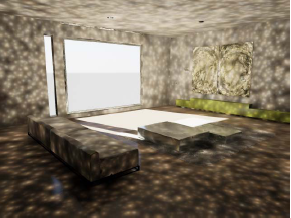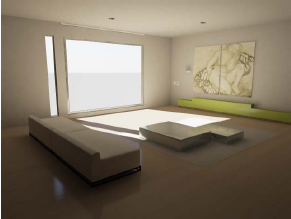The Render Manager > mental ray (Global Renderer)
The Render Manager > (select a pass) > mental ray
Set a current pass and choose Render > Render > Renderer Options from the Render toolbar.
Tab: Irradiance Particles
Options: Interpolation and Environment
The Accuracy options are the main settings used to control the render quality of an irradiance particles effect. In addition, interpolation can be used to reduce the rendering time without any obvious loss in the quality (although the effect may not be as accurate, in most cases to the naked eye, it will be good enough).
Setting Additional Indirect Passes
Set the number of additional Indirect Passes you want to use to collect the indirect lighting. When this option is greater than 0.0, a sequence of passes are done to collect the irradiance coming from every particle position, such that irradiance particles will contain both direct illumination and indirect illumination information. The default of 0.0 means that the irradiance particles will contain direct illumination information and the equivalent of one bounce of indirect lighting.
Specify the number of Rays that are shot from a shading point to collect illumination information. The contribution of these rays is averaged, which means that shooting more rays produces more accurate lighting. Sampling the particle map with many rays at every shading point, is the most precise way to calculate indirect illumination with irradiance particles, but it is also the slowest. Rendering times can be very long if you don't use point interpolation (see Setting Points for Interpolation).
The images below show different results when varying the number of rays without using interpolation:
Setting Points for Interpolation
Rendering time can be significantly shortened by using point interpolation.
Interpolation is active by default and is set to Always. If your scene has a lot of reflective and refractive surfaces, you can enable interpolation For Secondary Rays Only. You can also disable interpolation by selecting Never, which is something you may want to do if you are trying to test for how many rays would be needed to get the most accurate illumination effect.
When using interpolation, mental ray adds an extra final irradiance pass in the preprocessing step where it samples the particle map to gather the illumination information for each irradiance particle, which it will use later for interpolation.
When mental ray computes the irradiance at a shading point during rendering, it looks for the n closest irradiance particles, where n is the number of interpolation Points and computes the weighted sum of those irradiance values. This process is much faster than tracing the rays for every shading point.
The images below show the same scenes, but this time with interpolation set to Always, the number of interpolation points remain fixed, and the number of rays are varying as before. Now each scene results in much shorter rendering times. However, the higher quality render (512 rays) is not significantly better to warrant the additional render time, so (for the purpose of this example) the rendering of this scene is optimized at 256 rays with interpolation.

|
Rays = 2 Interpolation = Always Points = 64 |

|
Rays = 256 Interpolation = Always Points = 64 |

|
Rays = 512 Interpolation = Always Points = 64 |
The next step is to determine an optimal number of interpolation Points. The following images show what happens when the Points parameter is changed.